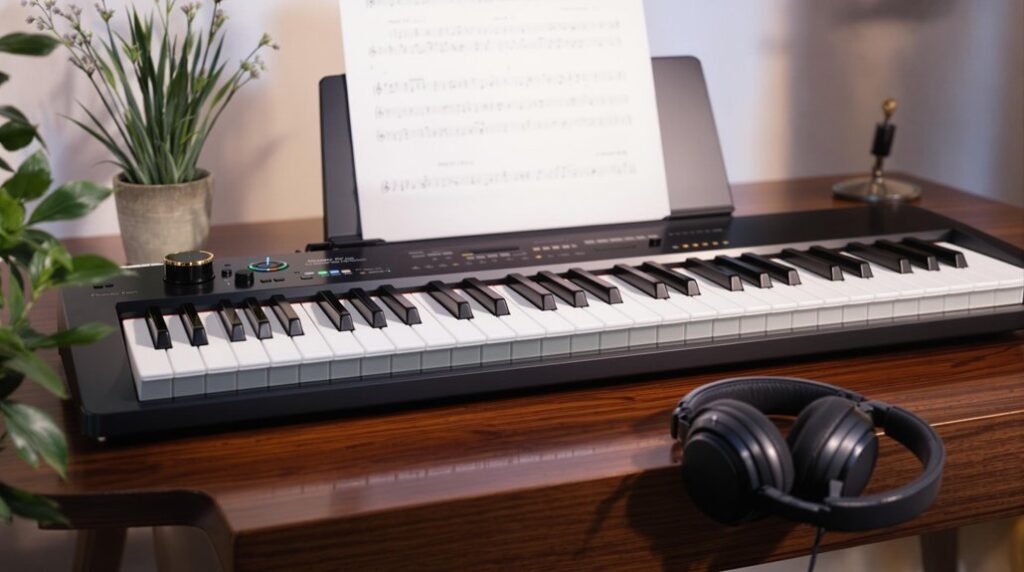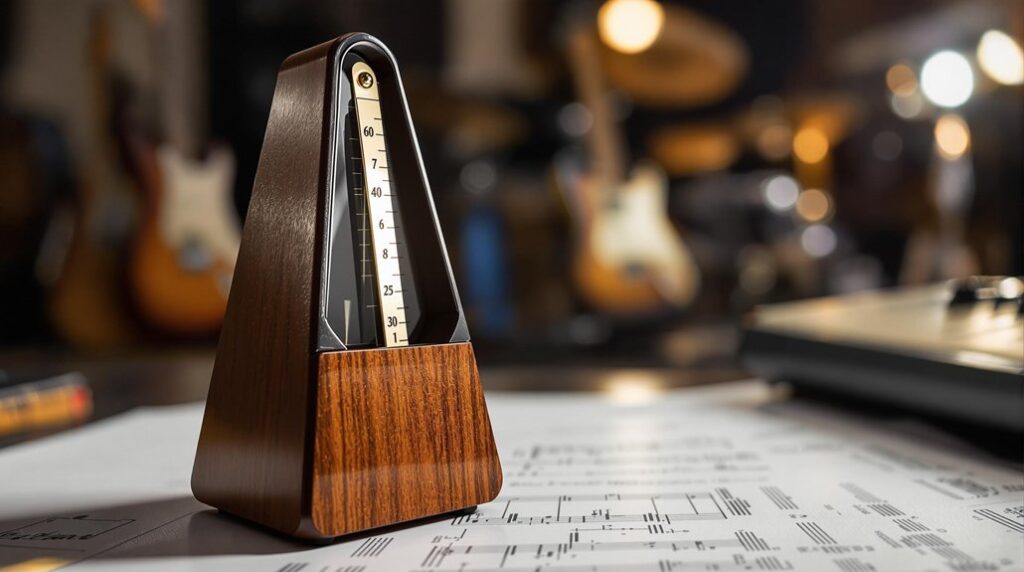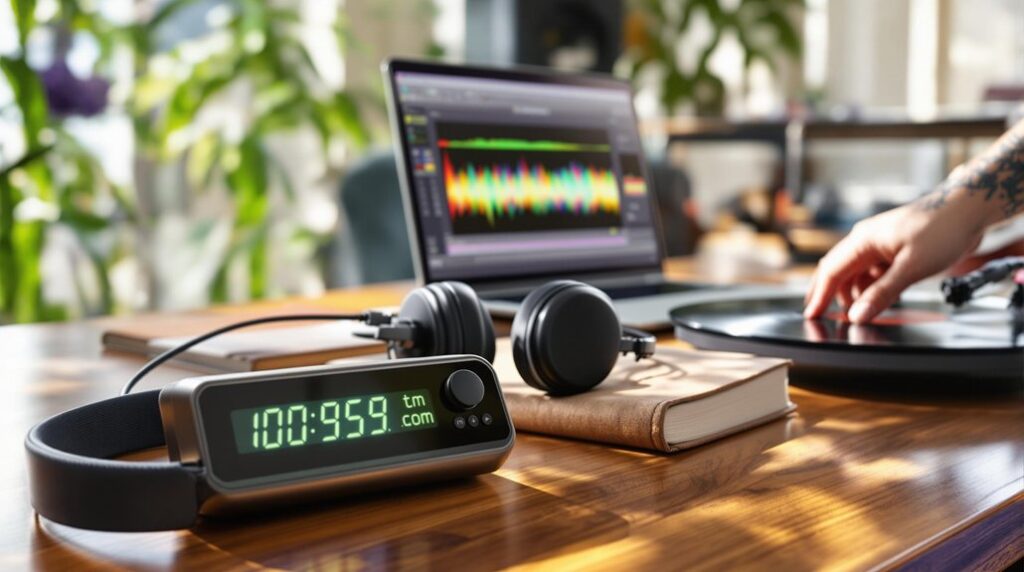Mastering the art of music production and melody crafting hinges on several key techniques. Enhance your work by delving into music theory, capturing emotional resonance through scale selection, and strategic use of silence. Choosing the right DAW that complements your workflow is essential, alongside continuous learning and feedback. Memorable melodies benefit from repetition, stepwise motion, and unexpected intervals, while layering sounds adds richness. Balance space and dynamics with volume automation and EQ for clarity. Address frequency clashes with surgical precision, enhancing spatial dynamics and preserving the emotional impact. Exploring these approaches further reveals the secrets to boosting your creativity.
Key Takeaways
- Study popular compositions to understand effective use of repetition and hooks for memorable melodies.
- Utilize EQ to carve out space for each instrument, preventing frequency clashes and enhancing mix clarity.
- Layer sounds to introduce depth and complexity, exploring innovative sound combinations.
- Experiment with modal interchange to add unique harmonic flavors and enhance melodic interest.
- Regularly cross-reference mixes on various speakers and headphones to ensure clarity and translation.
Master Music Theory
Mastering music theory is a crucial step for any aspiring music producer aiming to craft emotionally impactful compositions. Understanding major and minor scales is essential, as they form the foundation for catchy melodies and emotional depth. Major scales evoke happiness, while minor scales convey sadness, each influencing the mood of your music.
To master music theory, focus on chord progressions and relationships, which enhance harmonic richness. Modal interchange can be employed to introduce unique harmonic flavors, increasing melodic interest. Recognize scale degrees to identify the emotional color of melodies, crafting memorable hooks. Additionally, exploring chord inversions can add variety and depth to your compositions, making them more engaging to listeners.
Engaging in continuous learning through daily theory studies, like online courses, solidifies your foundation. This dedication empowers creativity in constructing intricate rhythmic patterns and emotionally resonant music.
Choose the Right DAW
How do you select the right Digital Audio Workstation (DAW) that best complements your creative workflow? The choice of a DAW is essential, as it opens up new possibilities for translating ideas into a signature sound.
Popular options like Ableton Live, FL Studio, and Logic Pro offer distinct features, from virtual instruments to advanced sound design tools. Investing time in exploring their user interfaces and navigation is vital for ensuring they match your comfort level and enhance productivity.
Many DAWs support third-party plugins, facilitating experimentation and allowing you to create something uniquely yours. Testing various DAWs through free trials can help identify which platform resonates with your style, thereby optimizing your efforts in music production and fostering creative exploration. Additionally, understanding the software landscape is crucial for musicians and producers as it drives technological innovation and revolutionizes music creation and production processes.
Create Memorable Melodies
To craft memorable melodies, it is essential to study popular compositions, identifying the structural elements that contribute to their enduring appeal.
Analyzing these works provides insights into effective use of repetition and emotional expressiveness.
Additionally, experimenting with diverse rhythmic patterns, such as syncopation and off-beat accents, can introduce unexpected turns that captivate listeners and enhance the musical narrative. Understanding core concepts of music theory can further elevate your melodic creativity and provide a solid foundation for your compositions.
Study Popular Melodies
Understanding the nuances of popular melodies can greatly enhance your ability to craft memorable tunes. By studying popular melodies, you can identify the use of repetitive motifs and catchy hooks that contribute to a song’s memorability.
Many chart-topping hits feature simple, stepwise motion with a focus on key notes, enhancing emotional engagement through dynamic phrasing and harmonic tension.
Exploring diverse genres reveals unique melodic approaches, inspiring creativity through variations in rhythm and phrasing. To boost your creativity, incorporate elements like syncopation and unexpected interval jumps, adding intrigue and uniqueness to your compositions.
This method not only creates a catchy melody but also guarantees the emotional resonance essential for engaging listeners, setting your music apart from the ordinary.
Experiment With Rhythms
In crafting unforgettable melodies, rhythm plays an equally pivotal role as melody itself. Experimenting with rhythm introduces new ideas that enhance the creative process, making melodies more memorable.
Incorporating off-beat accents and syncopation can craft infectious grooves, while rhythmic patterns like triplets and polyrhythms add complexity, enchanting listeners. Varying note lengths and strategically placed rests within the rhythmic structure can build tension and release, amplifying the emotional impact of a melody.
Studying popular songs provides insights into effective rhythmic techniques, revealing strategies for crafting catchy melodies. Additionally, blending rhythmic elements from different genres can innovate melody crafting, creating unique soundscapes that resonate across diverse audiences.
Embracing these rhythmic experiments is essential for producing compelling, memorable music.
Balance Space and Dynamics
Crafting a compelling musical experience hinges on the delicate balance between space and dynamics. Understanding the importance of this balance involves technical expertise in stereo imaging and managing dynamic ranges. Properly utilizing silence can build tension, creating a dynamic and engaging narrative. Incorporating panning techniques enhances spatial dynamics, ensuring each element has its own space within the mix. This spatial separation contributes to a more immersive sound, essential for enchanting listeners. Additionally, mastering gain staging is crucial to prevent distortion and maintain clarity in your audio production.
| Technique | Benefit |
|---|---|
| Strategic Silence | Enhances emotional impact |
| Panning | Improves spatial dynamics |
| Compression | Maintains emotional depth and quality |
Balancing loud and soft elements preserves clarity and emotional impact. However, over-compression flattens dynamics, reducing emotional depth. Skillfully managing these aspects sculpts a track’s energy and mood, guiding the audience’s emotional journey.
Layer Sounds for Depth
Building upon the balance of space and dynamics, layering sounds is a sophisticated technique that enriches a musical piece by introducing depth and complexity. By combining complementary textures, one can enhance the overall interest and richness of a track.
To achieve clarity and prevent muddiness, isolate frequency ranges for each layer using EQ, ensuring each sound occupies its own sonic space. Spatial dynamics can be further enhanced through panning techniques and reverb, adding movement and three-dimensionality. Understanding vocal frequency ranges is crucial, as it can help in reducing muddiness and enhancing the clarity of your layered sounds.
Adjusting the attack, sustain, release, and decay parameters creates cohesive soundscapes, fostering distinctive sonic profiles. Experimenting with sound combinations and layering techniques can propel creative stagnation, yielding innovative results and inspiring fresh musical ideas.
Key Techniques
- Isolate frequencies with EQ
- Utilize panning and reverb
- Experiment with sound combinations
Polish With Mixing Techniques
Refining a track with precise mixing techniques is essential to transforming a raw arrangement into a polished masterpiece.
Employing EQ strategically allows you to carve out sonic space, elevating your music by preventing frequency clashes among different instruments.
Utilize compression to achieve consistency, ensuring pivotal elements like vocals and lead instruments maintain their prominence.
Panning across the stereo field creates an immersive sound, enhancing your melody creation by allowing listeners to discern between various elements.
Volume automation facilitates dynamic adjustments, ensuring no element overshadows another, thereby maintaining the mix’s evolution.
Regularly cross-referencing your mix on different speakers and headphones hones your listening skills, helping identify clarity issues, and guaranteeing that your new sound translates seamlessly across diverse listening environments. Additionally, employing surgical EQ cuts can significantly enhance clarity by isolating and removing resonant problem frequencies.
Embrace Continuous Learning
While the terrain of music production continuously evolves, embracing a mindset of perpetual learning is essential for staying ahead. To create innovative melodies and refine your music production skills, consider the following strategies:
- Engage in Educational Opportunities: Enroll in online courses and workshops to enhance specific skills such as mixing, sound design, and music theory. This structured learning can provide a solid foundation to create compelling ideas.
- Seek Constructive Feedback: Interacting with peers and mentors can yield valuable insights, facilitating personal growth and novel creative approaches in music production.
- Experiment and Network: Regularly experiment with different genres and styles to inspire fresh musical ideas. Additionally, keep abreast of music production trends to ensure your work remains relevant and innovative.
Networking with fellow musicians at industry events can lead to collaborative opportunities, further enriching the learning process and expanding your creative horizons.
Overcome Common Challenges
In the domain of music production, addressing frequency clashes is vital for achieving a polished and harmonious sound. This requires precise equalization and thoughtful layering to guarantee each element occupies its own sonic space. Additionally, understanding frequency management is crucial in ensuring that each instrument fits well within the mix, contributing to an overall cohesive auditory experience. Enhancing emotional impact involves mastering the art of dynamics and modulation, allowing producers to craft compositions that resonate deeply with listeners.
Addressing Frequency Clashes
How often do you find your mix muddied by overlapping frequencies, obscuring the clarity of your musical elements? Addressing frequency clashes is essential for maintaining a polished sound. Utilizing EQ effectively can carve out space for each instrument, preventing these clashes.
Start by analyzing your mix with spectrum analyzers to visually identify frequency overlaps. This enables informed adjustments to enhance clarity.
Consider the following strategies:
- EQ and Filtering: Use a high-pass filter on conflicting elements like kick drums and bass to maintain clarity in the low end.
- Stereo Image: Panning instruments away from the center can widen the stereo image, minimizing perceived frequency clashes.
- Reference Professional Tracks: Regularly compare your mix against industry-standard tracks to identify and rectify frequency issues, achieving a balanced sound.
Enhancing Emotional Impact
Emotion is the lifeblood of music, transforming simple melodies into profound experiences that resonate deeply with listeners. To enhance the emotional impact of your compositions, consider the strategic use of silence and dynamic range to create tension and release. This can uplift a melody’s emotive power.
Integrating modal interchange by borrowing chords from parallel major and minor scales adds nuanced emotions, enriching musical depth. A well-defined structure, such as AABA or ABAB, guarantees seamless shifts essential for engaging listeners emotionally.
Experimenting with syncopation introduces rhythmic surprises, making melodies more engaging. Regular analysis of emotional responses to various chord progressions helps refine your sound, aligning creative choices with the intended emotional journey, assuring your music truly resonates.
Frequently Asked Questions
How to Increase Creativity in Music Production?
To enhance creativity in music production, engage in collaborative projects, explore diverse genres, and employ improvisation techniques. Incorporate sound experimentation, take mental breaks, and curate inspirational playlists to stimulate innovative approaches and broaden musical perspectives effectively.
How to Actually Get Better at Music Production?
To improve in music production, master your music software, explore innovative sound design, enhance mixing techniques, and employ effective arrangement strategies. Engage in beat making and embrace collaboration ideas to refine your skills and expand your creative toolkit.
How to Spark Musical Creativity?
To spark musical creativity, employ brainstorming techniques, engage in genre exploration, and participate in collaborative sessions. Incorporate improvisation exercises and sound experimentation, while drawing inspiration from nature to cultivate a rich and innovative creative process.
How Do Musicians Generate Creative Ideas?
Musicians generate creative ideas through improvisation techniques, collaboration benefits, and genre exploration. Sound experimentation and mood inspiration contribute by enabling storytelling elements, fostering a dynamic creative process that encourages innovative and diverse musical compositions.
Conclusion
In the pursuit of mastering music production and melody crafting, adherence to foundational principles such as music theory and the selection of an appropriate digital audio workstation proves essential. Crafting memorable melodies necessitates a nuanced balance of space and dynamics, further enriched by strategic layering of sounds. Advanced mixing techniques polish the composition, while a commitment to continuous learning facilitates adaptation to evolving trends. Addressing common challenges with a methodical approach fosters sustained creative growth and innovation.




